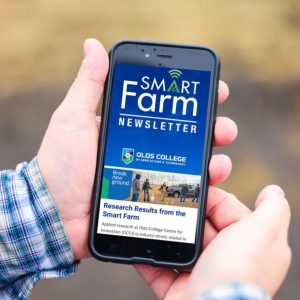At first, it was known simply as a demonstration farm. Then, in 1913, it was established as the Olds Agricultural Farm.
Today, Olds College of Agriculture & Technology (OCAT) in central Alberta is leading the development of a cross-Canada smart farm network, making use of advanced smart systems and related technologies to greatly improve agricultural productivity.
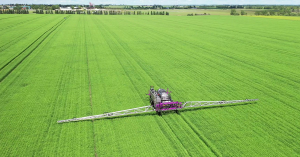
Olds College of Agriculture & Technology (OCAT) in central Alberta is leading the development of a cross-Canada smart farm network, making use of advanced smart systems and related technologies to greatly improve agricultural productivity.
Smart farm initiatives are sprouting up around the globe, advancing proven agricultural technologies and developing new smart initiatives to boost crop resiliency, food production, and overall sector performance.
Smart farming is also known as digital agriculture, ag-tech or precision ag, even controlled environment agriculture. It seeks to harness the power of big data and digital technology – smartphones and computers, sensors and monitors, machine learning programs and artificial intelligence algorithms – to help farmers meet the demands of a growing global population, anticipate emerging transportation and infrastructure issues, and cope with a changing climate and economic environment.
Among the many smart farm technologies being developed and applied are software tools to collect, store, analyze and visualize farm production results and management data; field monitoring equipment like video cameras, multi-spectrum light detectors, temperature and humidity sensors; aerial monitoring devices and UAVs (unmanned aerial vehicles); wireless mesh and rural narrowband connectivity for high-speed Internet access; and big data analytics, machine learning and artificial intelligence programs to turn gathered data and crop information into greater opportunity and productivity.
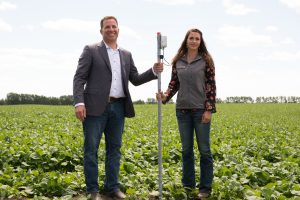
Stuart Cullum, President of Olds College, and Catalina Oitzl, Olds College Student, plant a soil and crop evaluation sensor into the Olds College Smart Farm at its opening (CNW Group/Olds College)
Olds College launched its local Smart Farm in June, 2018, growing it into a 3,600-acre space for crop and forage production, a feedlot with a 1,000-head capacity and a Purebred Red Angus beef herd, a sheep flock, a greenhouse and other facilities where smart technologies are researched and developed.
Now, experiences at Olds College’s original Smart Farm have led to the wider Canadian Smart Farm network and a broad-based collaborative environment where farmers, industry, and technology developers can better develop and apply smart agriculture technologies and systems.
The expansion into Ontario of the Pan-Canadian Smart Farm Network (PCSFN), led by Olds, will have direct benefit for the college and its members, OCAT vice-president of research Joy Agnew said when a new member, Discovery Farm Woodstock, a 330-acre demonstration farm and events facility in Ontario, joined the Network.
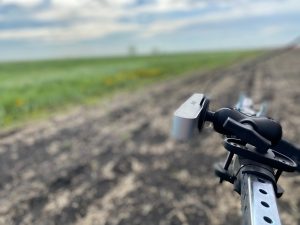
Among the many smart farm technologies being developed and applied are software tools to collect, store, analyze and visualize farm production results and management data.
That brings the total number of PCSFN collaborating members to eight across four provinces, all looking at ways to make the industry more efficient and resilient by taking advantage of high-tech solutions identified by researchers, producers, and other industry partners.
In addition to Olds College and Discovery Farm Woodstock, the Pan-Canadian Smart Farm Network includes Lakeland College, Lethbridge College, Discovery Farm Langham (near Saskatoon), the University of Saskatchewan, Manitoba Beef & Forage Initiatives Inc. and the commercial Enterprise Machine Intelligence and Learning Initiative (EMILI) in Winnipeg.
As one example of their collaboration, Olds and EMILI are working on “smart weed identification”, collecting data and developing techniques to help spur green-on-green detection of different invasive or harmful weeds in a valuable crop field. Even when using a sensor array in a 5,500-acre field for an entire crop year, the detection (then spraying and eradicating) of undesirable weeds – also a green plant – in a field of green growing cash crops is a complex task, one much more
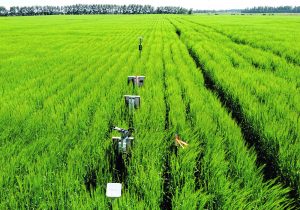
A project at the Olds College Smart Farm, called Advancing Agronomy Through HyperLayer Data Collection and Analytics, produces and stores agricultural data sets, including soil nutrient tests, moisture maps, topographical information, yield data, as well as multispectral and hyperspectral imagery. Photo supplied by Alex Melnitchouk
complicated than traditional green-on-brown (plants in soil) detection.
Another very high-tech way of monitoring the crops grown on a smart farm is with an eye in the sky, and one of the best is on the International Space Station.
High-resolution imaging devices on the ISS were used to take hyperspectral shots of the college’s Smart Farm as it passed overhead in 2020. Unlike regular photos from a cellphone, say, which are based on three colours – red, green and blue – and then combined into one colour image, a hyperspectral image has some 200 colour bands, including infrared, which when combined yields not just a visual image of the plant but a map of biochemical processes within the plant itself, as well as the interactions between crops, soils and the local environment.
Alex Melnitchouk, chief technology officer of digital agriculture for Olds College, described the HyperLayer project and the information it’s helping researchers gather about biomass health and density, soil nutrients, crop diseases, yield data and more. The information is used to train artificial intelligence and machine learning programs.
A multi-year, multi-million-dollar initiative, the Olds College Smart Farm continues to grow, with new members, participants and acreage being added almost every season (and described in its online newsletter). The partnership among post-secondary institutions, industry providers and suppliers, and local producers is yielding a wealth of ag-tech insights that should help all players in the industry, including consumers.
-30-
